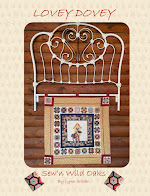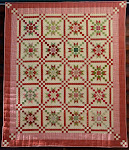Hello Everyone,
I've taught Spoken For a couple of times, and I've noticed how the blocks seem to be all over the spectrum when it comes to the final size, so I put a tutorial together to walk you through the process.
Begin with the end in mind.
Select three fabrics that play well together. I always begin with the "Blade" fabric. The blade is the pointy piece in the block. The fans are the rounded sections. Key off your blade fabric, by selecting fabrics that work with it, and you can't go wrong.
I put a piece of template plastic over the template page of the pattern and made my templates. I used a ruler and an ultra fine permanent marking pen and traced the templates on the plastic. Template plastic comes in a blue or red gridded form or plain. I prefer the gridded template plastic. Cut the template out directly on the line.
Trace around the template and cut out directly on the line. You will need to make 4 blades.
Fold the blade in half and pin.
Stitch 1/4" from the raw edge of the blade to the folded edge.
Backtrack at the end and clip off the inside, folded corner.
Press the seam open.
Use a little pointy thingy to make a nice sharp point, and press. Now you are finished with the blades.
Now use your fan template and cut out your fans. Since I wasn't fussy cutting them, I traced around the fan template on the back of the fabric. I carefully cut out each fan directly on the line.
I then made my freezer paper template. I ironed three pieces of freezer paper together and made a stiff freezer paper template.
Clip to the freezer paper right here.
Gather your applique tools together. Apply a bit of starch to the end of the fan.
Use an iron and stiletto and press the fabric over the freezer paper.
Prepare 16 fans for your block.
This is what the back will look like on both sides of the sections.
You can press the seams open if you don't plan of stitching in the ditch. If you do plan on stitching in the ditch, then press the seams to one side. I experimented to see if there was any difference in the size of the block if the seams were pressed open or to one side. The conclusion of my unscientific experiment showed the blocks were a smidge larger if the seams were pressed open. My only explanation is the block can stretch a bit more if the seams are pressed open.
Continue sewing, and PRESS after each addition to the block.
If the block is a little wonky or wavy when it is all sewn together, (especially in the middle around the "pie hole"), give it a good shot of heavy duty spray starch, let it dry, then iron it into submission. I admit I had to do this step on more than one occasion.
Make your hexagon templates from the template plastic. First cut out the fabric hexagon. Make a freezer paper template, and iron on to the back of the hexagon.
Use starch, an iron, fold and press the fabric over the template.
Carefully remove the freezer paper template and place on top of the block. The block is now ready to hand applique to the background fabric. You can also think about machine appliqueing the block to the background.
From tip of blade to tip of blade, the block should measure between 7-1/2" to 7-5/8". The "pie hole" in the center should measure between 2" to 2-1/8".
I can't give away the farm here, so continue making the quilt by following the directions on the pattern which is available HERE. Once you refine your process, the blocks become very addicting. Maybe that's why I'm making another Spoken For!
Soon,
Lynn
I've taught Spoken For a couple of times, and I've noticed how the blocks seem to be all over the spectrum when it comes to the final size, so I put a tutorial together to walk you through the process.
Begin with the end in mind.
Select three fabrics that play well together. I always begin with the "Blade" fabric. The blade is the pointy piece in the block. The fans are the rounded sections. Key off your blade fabric, by selecting fabrics that work with it, and you can't go wrong.
I put a piece of template plastic over the template page of the pattern and made my templates. I used a ruler and an ultra fine permanent marking pen and traced the templates on the plastic. Template plastic comes in a blue or red gridded form or plain. I prefer the gridded template plastic. Cut the template out directly on the line.
I love using the plastic so I can place it over the fabric and be able to fussy cut the blade.
Trace around the template and cut out directly on the line. You will need to make 4 blades.
Fold the blade in half and pin.
Stitch 1/4" from the raw edge of the blade to the folded edge.
Press the seam open.
Use a little pointy thingy to make a nice sharp point, and press. Now you are finished with the blades.
Now use your fan template and cut out your fans. Since I wasn't fussy cutting them, I traced around the fan template on the back of the fabric. I carefully cut out each fan directly on the line.
I then made my freezer paper template. I ironed three pieces of freezer paper together and made a stiff freezer paper template.
Iron the freezer paper template to the back of the fans.
Use an iron and stiletto and press the fabric over the freezer paper.
Prepare 16 fans for your block.
Carefully peel the freezer paper away from the fans. It helps to briefly press the back of the fan to help release the freezer paper.
Place right sides together, and begin stitching at the opening in the center of the block and stitch to the outside. Backtrack at the beginning and the end.
****IMPORTANT***** There are 20 seams around the block. Make sure your seam is 1/4".
This is what the back will look like on both sides of the sections.
You can press the seams open if you don't plan of stitching in the ditch. If you do plan on stitching in the ditch, then press the seams to one side. I experimented to see if there was any difference in the size of the block if the seams were pressed open or to one side. The conclusion of my unscientific experiment showed the blocks were a smidge larger if the seams were pressed open. My only explanation is the block can stretch a bit more if the seams are pressed open.
Continue sewing, and PRESS after each addition to the block.
If the block is a little wonky or wavy when it is all sewn together, (especially in the middle around the "pie hole"), give it a good shot of heavy duty spray starch, let it dry, then iron it into submission. I admit I had to do this step on more than one occasion.
Make your hexagon templates from the template plastic. First cut out the fabric hexagon. Make a freezer paper template, and iron on to the back of the hexagon.
Carefully remove the freezer paper template and place on top of the block. The block is now ready to hand applique to the background fabric. You can also think about machine appliqueing the block to the background.
From tip of blade to tip of blade, the block should measure between 7-1/2" to 7-5/8". The "pie hole" in the center should measure between 2" to 2-1/8".
I can't give away the farm here, so continue making the quilt by following the directions on the pattern which is available HERE. Once you refine your process, the blocks become very addicting. Maybe that's why I'm making another Spoken For!
Soon,
Lynn























































































Wonderful tutorial, Lynn! Thanks! You'll see me at the retreat with Spoken For!
ReplyDeleteCheers!
Great tutorial with excellent pictures, as usual! Maybe the bigger size in the pressed open seam block makers is due to machine tension being a little loose.
ReplyDeleteThanks so much for a wonderful tutorial.
ReplyDeleteThanks for a great tutorial Lynn! If using apliquick for this project, you would cut the interfacing the finished size of the blades and fans, correct? This might also stabilize the plate as well!
ReplyDelete